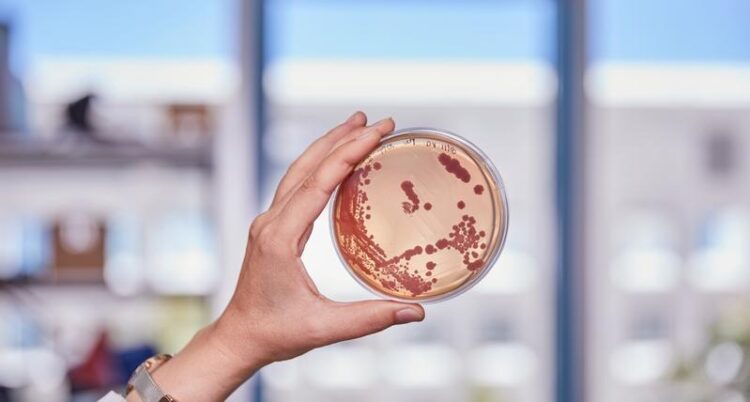A new path to drug diversity

Bacteria are a source of molecular "assembly lines" that can be used and optimized for the production of new bioactive substances.
Credit: MPI f. Terrestrial Microbiology/ Chris Kettner
Research on protein evolution reveals new starting points for the rapid and targeted development of future drugs.
Many important medicines, such as antibiotics and anticancer drugs, are derived from natural products from Bacteria. The enzyme complexes that produce these active ingredients have a modular design that makes them ideal tools for synthetic biology. By exploring protein evolution, a team led by Helge Bode from the Max Planck Institute for Terrestrial Microbiology in Marburg, Germany, has found new “fusion sites” that enable faster and more targeted drug development.
Industry often follows the assembly line principle: components are systematically assembled into complex products, with different production lines yielding different products. However, not humans are the actual inventors of this principle, but bacteria. Non-ribosomal peptide synthetases (NRPS) are bacterial enzymes that, like production lines, produce an immense variety of natural products. They enable bacteria to survive in a wide variety of natural habitats. Humans have benefited significantly from these enzyme complexes, as they are the origin of many important drugs like antibiotics.
Multitude of enzyme variants generates diversity of natural substances
The research group of Helge Bode at the Max Planck Institute for Terrestrial Microbiology in Marburg is investigating the use of these enzyme systems for the targeted production of drugs in the laboratory. The researchers modify parts of the enzymes and thus the functional properties of the entire enzyme complexes (NRPS engineering) in order to produce products with new properties. However, although this concept has been pursued for several years, it has not yet worked as hoped. “We realized that there is a great opportunity in taking nature as a model. If we understand the natural processes, we will know which areas of the enzyme are best suited for NRPS engineering,” explains Kenan Bozhüyük.
Recombination following the natural model
To find out which subunits of the enzyme work particularly well together, the team focused on the question: What are the positions that evolution itself applies to establish or change the new “assembly lines” to create the required active compounds? Together with the group of Georg Hochberg from the Max Planck Institute for Terrestrial Microbiology and Michael Groll (from the Technical University Munich, the team screened for “hotspots” of natural recombination. “We analyzed several tens of thousands of enzymes bioinformatically and then combined the analysis with laboratory experiments to verify the predicted target sites,” explain the first authors Leonard Präve and Carsten Kegler.
In fact, the team found a new “fusion point” for the targeted production of functional NRPS hybrids. They were even able to combine NRPS sequences from completely different organisms, such as bacteria and fungi.
The researchers then tested their new knowledge in a medical context: They constructed a new, pharmacologically active peptide. The comprehensive study demonstrates the great potential of bacterial natural products as the basis for new drugs.
The aim is to create customised medicines
“Research in both, synthetic biology and evolutionary biochemistry, has made enormous progress in recent years,” said Bode, Director at the Max Planck Institute in Marburg. “The key advantage of our approach is that we are using evolutionary processes that have proven themselves over millions of years. Our evolution-inspired fusion sites are more versatile and have higher success rates.”
The team’s concept combines synthetic biology with the high-throughput methods needed to discover biologically active compounds faster and more cost-effectively. In this way, the researchers hope to develop customized biological drugs with improved therapeutic properties – something that is becoming increasingly important in view of the rise in drug resistance and drug intolerance.
Journal: Science
DOI: 10.1126/science.adg4320
Article Title: Evolution inspired engineering of non-ribosomal peptide synthetases
Article Publication Date: 22-Mar-2024
Media Contact
All latest news from the category: Life Sciences and Chemistry
Articles and reports from the Life Sciences and chemistry area deal with applied and basic research into modern biology, chemistry and human medicine.
Valuable information can be found on a range of life sciences fields including bacteriology, biochemistry, bionics, bioinformatics, biophysics, biotechnology, genetics, geobotany, human biology, marine biology, microbiology, molecular biology, cellular biology, zoology, bioinorganic chemistry, microchemistry and environmental chemistry.
Newest articles

NASA: Mystery of life’s handedness deepens
The mystery of why life uses molecules with specific orientations has deepened with a NASA-funded discovery that RNA — a key molecule thought to have potentially held the instructions for…

What are the effects of historic lithium mining on water quality?
Study reveals low levels of common contaminants but high levels of other elements in waters associated with an abandoned lithium mine. Lithium ore and mining waste from a historic lithium…

Quantum-inspired design boosts efficiency of heat-to-electricity conversion
Rice engineers take unconventional route to improving thermophotovoltaic systems. Researchers at Rice University have found a new way to improve a key element of thermophotovoltaic (TPV) systems, which convert heat…



